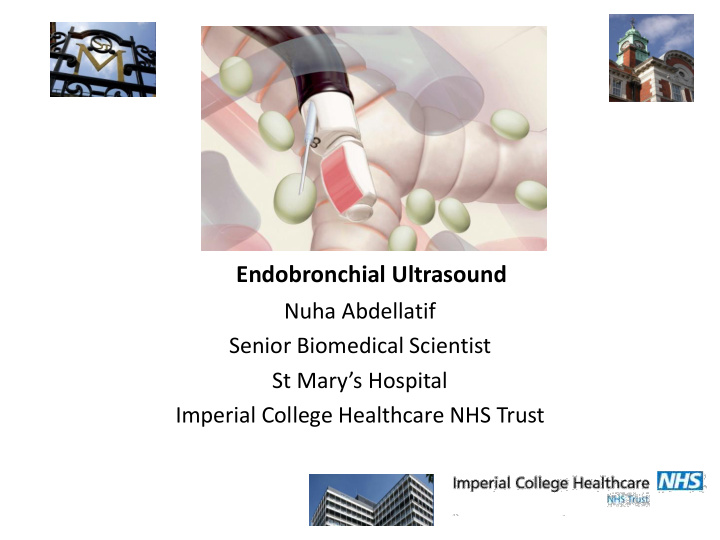



Endobronchial Ultrasound Nuha Abdellatif Senior Biomedical Scientist St Mary’s Hospital Imperial College Healthcare NHS Trust
Expanding beyond the airway • Airway lesions visible by conventional bronchoscopy • Mediastinal node sampling • Peri-bronchial lesions not visible
Benefits of Ebus Provides real-time imaging of the surface of the airways, blood vessels, lungs, and lymph nodes Allows access to difficult-to-reach areas and accesses small lymph nodes Rapid onsite pathologic evaluation Pathologists/ Biomedical Scientists in the operating room can process and examine samples as they are obtained and can request additional samples to be taken immediately if needed EBUS is performed under moderate sedation or general anaesthesia Patients recover quickly and can usually go home the same day as minimally invasive procedure
Advantage of Biomedical Scientists attending EBUS - Extremely Rapid as Biomedical Scientists onsite - Cost Effective Ebus training for Biomedical Scientists available in house - Implementation of HPV Primary Screening in 2020 for Cervical Cytology will result in more Biomedical Scientists available to attend EBUS
Summary • EBUS useful in granulomatous disease AND in ensuring target is being reached when abnormalities is suspected • High sensitivity in TB and sarcoidosis • Non-caseating granuloma not exclusive to sarcoidosis • PCR – rapid and as good as smear – Does not replace culture • Using 3 mode testing (cytology/micro-PCR/IGRA) gives excellent sensitivity in TB • Lymphoma issues, flow cytometry invaluable
Slides
CASE 1 MN18-251 Collection of epithelial macrophages and histiocytes. Some are dispersed. No necrosis. Second pass has many lymphoid cells PAP slide does not mimic the MGG slides Granuloma present in clot
Case 2 CN17-344 Moderately Cellular Sample with singly dispersed and loosely cohesive epithelial cells Cells are pleomorphic and hyperchromatic Metastatic High Grade Carcinoma
CASE 3 MN17-532 Young man with intermittent fever, night sweats and weight loss. Rapid stain is highly cellular population Cells are large with scant cytoplasm. Nuclei contain coarse chromatin with prominent nucleoli -High Grade Non Hodgkin Lymphoma
CASE 4 MN17-2024 Atypical cells in small groups. Cells have small amount of cytopasm. Nuclear chromation is finely dispersed with inconspicuous nucleoli NUCLEAR MOULDING IS SEEN METASTATIC SMALL CELL CARCINOMA
CASE 5 HN555 Squamous Cell Carcinoma
Case 6 MN17-939 Crowded Groups of atypical cells Pleormphic nuclei with coarse chromatin, small nucleoli Acinar formation in some groups Metastatic carcinoma- favouring adenocarcinoma
Case 7 MN17-2207 - Evidence of LN sampling in first pass and no atypical cells Small and Large lymph node population present some that are reactive. Second pass has clusters of cells with prominent nucleeoli, vacoulated cytoplasm and some have signet cell appearance Metastatic breast cancer as Oestrogen Receptor Positive
CASE 8 MN17-900 -Cohesive groups of atypical cells, nuclear overlapping with enlarged nucleus with prominent nucleoli Focal Necrosis is present METASTIC ADENOCARCINOMA
CASE 9 MN17-1251 Population of small singly dispersed atypical cells with minimal cytoplasm. Inconspicuous nucleoli, fine chromatin and nuclear moulding SMALL CELL CARCINOMA
CASE 10 MN17-2026 - Polymorphous population of lymphoid cells with anthrocotic histiocytes suggesting sinus histiocytes and not granuloma REACTIVE LYMPH NODE
CASE 11 MN14-1066 Astroid bodies seen and no necrosis. Numerous epithelioid granulomas with no necrosis SARCOIDOSIS
CASE 12 MN17-1062 Atypical cells in small groups and predominantly single cells. High nucleocytoplasmic ratio and moderate amount of vacuolated cytoplasm Nuclear chromatin is vesicular with small nucleoli METASTATIC non SMALL CELL CARCINOMA- favouring ADENOCARCINOMA
Recommend
More recommend